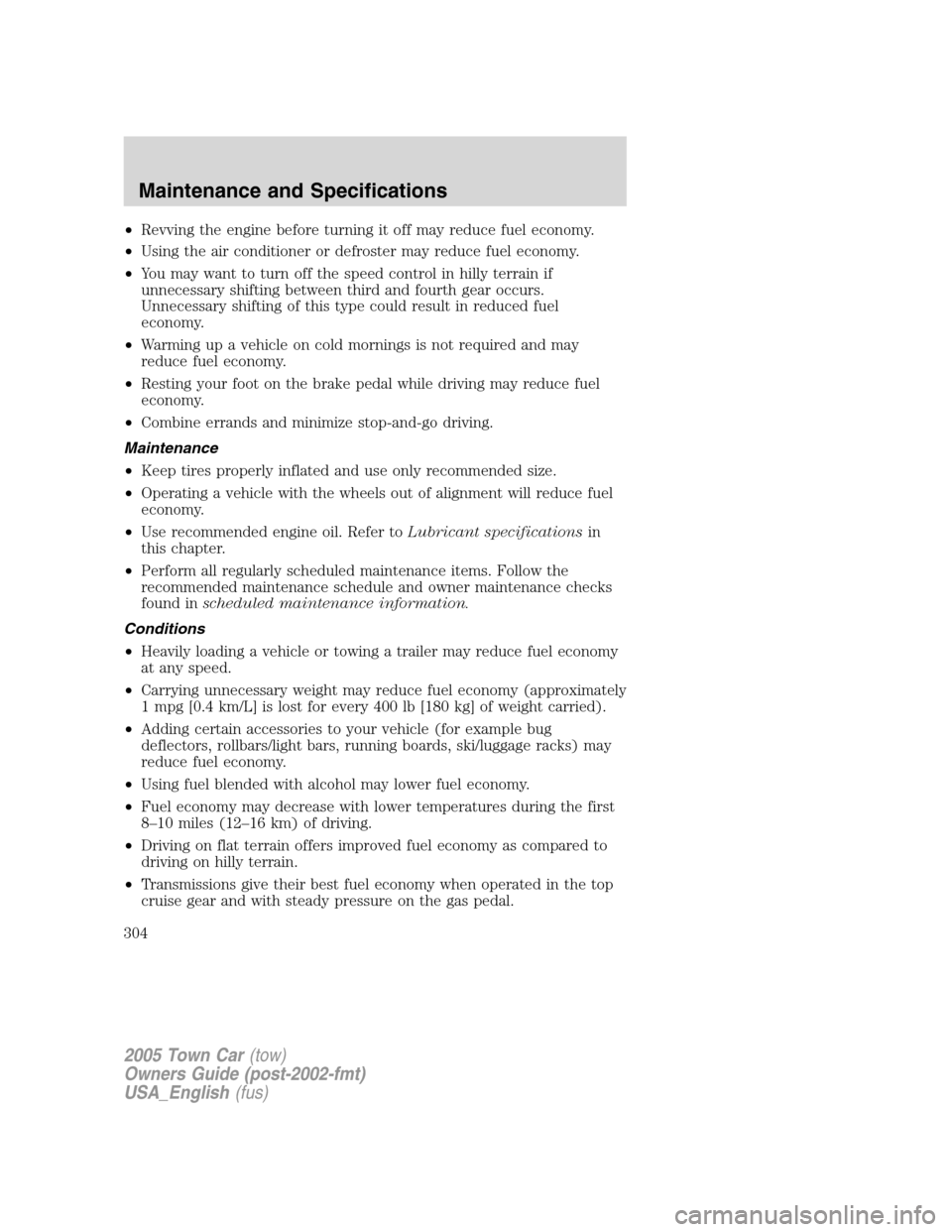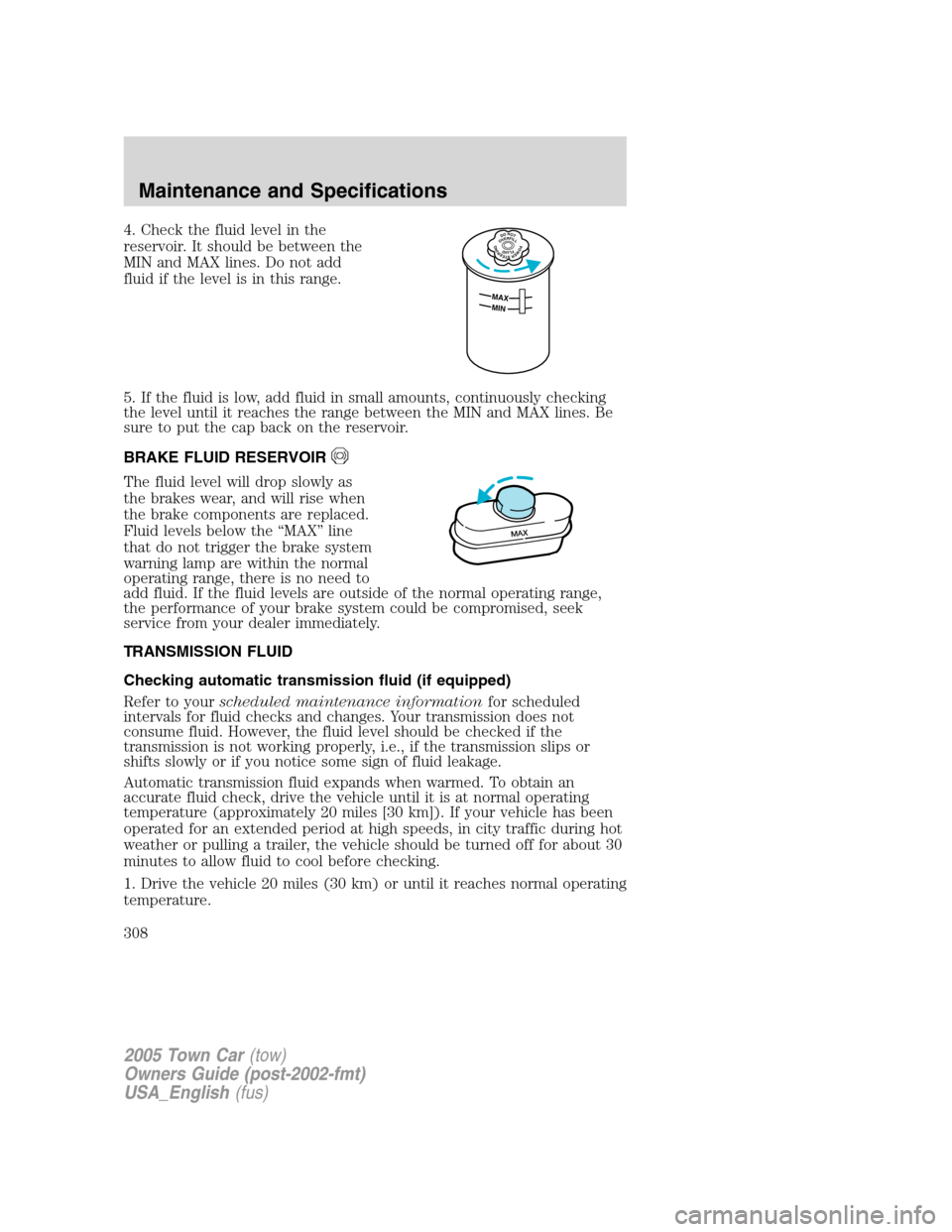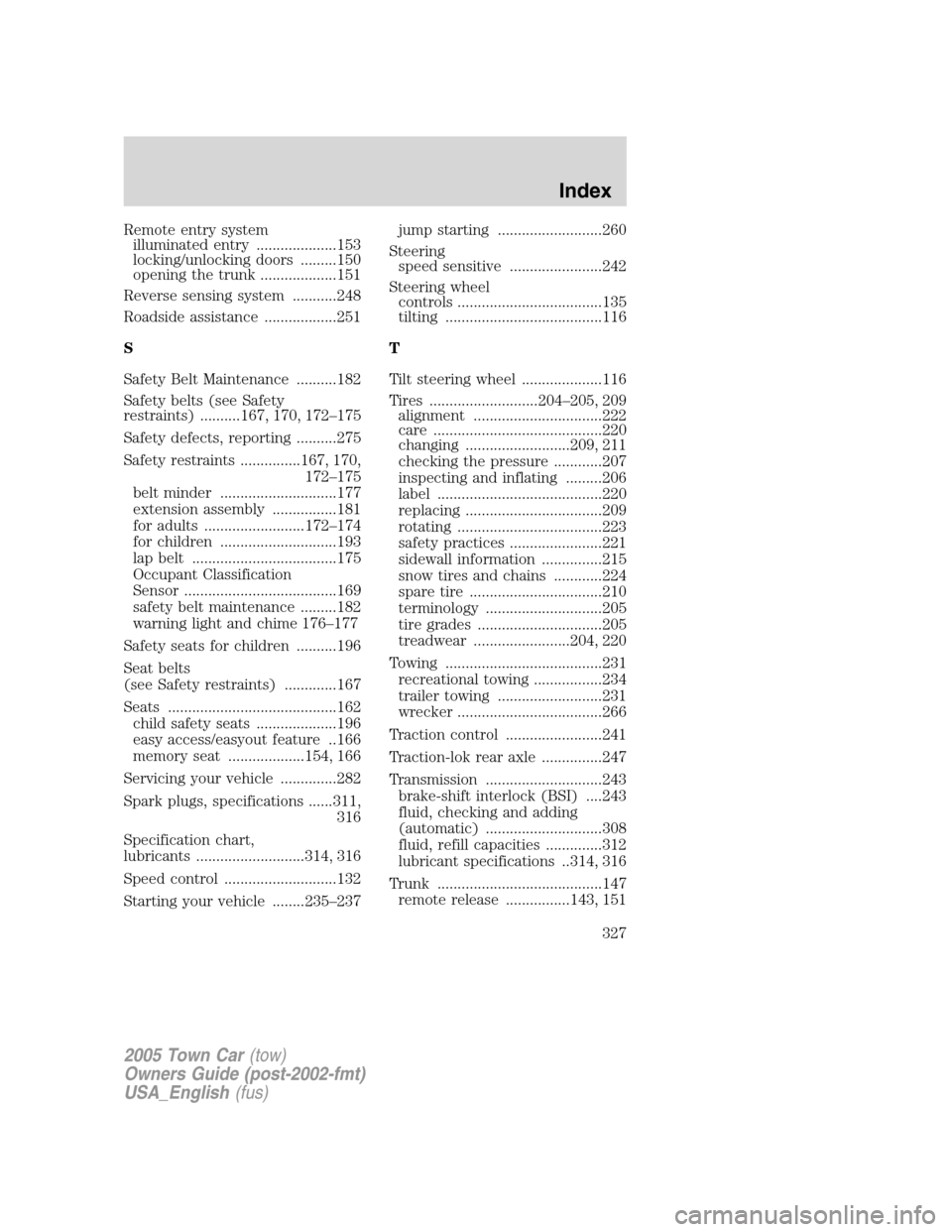Page 304 of 328

•Revving the engine before turning it off may reduce fuel economy.
•Using the air conditioner or defroster may reduce fuel economy.
•You may want to turn off the speed control in hilly terrain if
unnecessary shifting between third and fourth gear occurs.
Unnecessary shifting of this type could result in reduced fuel
economy.
•Warming up a vehicle on cold mornings is not required and may
reduce fuel economy.
•Resting your foot on the brake pedal while driving may reduce fuel
economy.
•Combine errands and minimize stop-and-go driving.
Maintenance
•Keep tires properly inflated and use only recommended size.
•Operating a vehicle with the wheels out of alignment will reduce fuel
economy.
•Use recommended engine oil. Refer toLubricant specificationsin
this chapter.
•Perform all regularly scheduled maintenance items. Follow the
recommended maintenance schedule and owner maintenance checks
found inscheduled maintenance information.
Conditions
•Heavily loading a vehicle or towing a trailer may reduce fuel economy
at any speed.
•Carrying unnecessary weight may reduce fuel economy (approximately
1 mpg [0.4 km/L] is lost for every 400 lb [180 kg] of weight carried).
•Adding certain accessories to your vehicle (for example bug
deflectors, rollbars/light bars, running boards, ski/luggage racks) may
reduce fuel economy.
•Using fuel blended with alcohol may lower fuel economy.
•Fuel economy may decrease with lower temperatures during the first
8–10 miles (12–16 km) of driving.
•Driving on flat terrain offers improved fuel economy as compared to
driving on hilly terrain.
•Transmissions give their best fuel economy when operated in the top
cruise gear and with steady pressure on the gas pedal.
2005 Town Car(tow)
Owners Guide (post-2002-fmt)
USA_English(fus)
Maintenance and Specifications
304
Page 308 of 328

4. Check the fluid level in the
reservoir. It should be between the
MIN and MAX lines. Do not add
fluid if the level is in this range.
5. If the fluid is low, add fluid in small amounts, continuously checking
the level until it reaches the range between the MIN and MAX lines. Be
sure to put the cap back on the reservoir.
BRAKE FLUID RESERVOIR
The fluid level will drop slowly as
the brakes wear, and will rise when
the brake components are replaced.
Fluid levels below the “MAX” line
that do not trigger the brake system
warning lamp are within the normal
operating range, there is no need to
add fluid. If the fluid levels are outside of the normal operating range,
the performance of your brake system could be compromised, seek
service from your dealer immediately.
TRANSMISSION FLUID
Checking automatic transmission fluid (if equipped)
Refer to yourscheduled maintenance informationfor scheduled
intervals for fluid checks and changes. Your transmission does not
consume fluid. However, the fluid level should be checked if the
transmission is not working properly, i.e., if the transmission slips or
shifts slowly or if you notice some sign of fluid leakage.
Automatic transmission fluid expands when warmed. To obtain an
accurate fluid check, drive the vehicle until it is at normal operating
temperature (approximately 20 miles [30 km]). If your vehicle has been
operated for an extended period at high speeds, in city traffic during hot
weather or pulling a trailer, the vehicle should be turned off for about 30
minutes to allow fluid to cool before checking.
1. Drive the vehicle 20 miles (30 km) or until it reaches normal operating
temperature.
DONOTOVERFILLPOWERSTEERINGFLUID
MAX
MIN
MAX
2005 Town Car(tow)
Owners Guide (post-2002-fmt)
USA_English(fus)
Maintenance and Specifications
308
Page 327 of 328

Remote entry system
illuminated entry ....................153
locking/unlocking doors .........150
opening the trunk ...................151
Reverse sensing system ...........248
Roadside assistance ..................251
S
Safety Belt Maintenance ..........182
Safety belts (see Safety
restraints) ..........167, 170, 172–175
Safety defects, reporting ..........275
Safety restraints ...............167, 170,
172–175
belt minder .............................177
extension assembly ................181
for adults .........................172–174
for children .............................193
lap belt ....................................175
Occupant Classification
Sensor ......................................169
safety belt maintenance .........182
warning light and chime 176–177
Safety seats for children ..........196
Seat belts
(see Safety restraints) .............167
Seats ..........................................162
child safety seats ....................196
easy access/easyout feature ..166
memory seat ...................154, 166
Servicing your vehicle ..............282
Spark plugs, specifications ......311,
316
Specification chart,
lubricants ...........................314, 316
Speed control ............................132
Starting your vehicle ........235–237jump starting ..........................260
Steering
speed sensitive .......................242
Steering wheel
controls ....................................135
tilting .......................................116
T
Tilt steering wheel ....................116
Tires ...........................204–205, 209
alignment ................................222
care ..........................................220
changing ..........................209, 211
checking the pressure ............207
inspecting and inflating .........206
label .........................................220
replacing ..................................209
rotating ....................................223
safety practices .......................221
sidewall information ...............215
snow tires and chains ............224
spare tire .................................210
terminology .............................205
tire grades ...............................205
treadwear ........................204, 220
Towing .......................................231
recreational towing .................234
trailer towing ..........................231
wrecker ....................................266
Traction control ........................241
Traction-lok rear axle ...............247
Transmission .............................243
brake-shift interlock (BSI) ....243
fluid, checking and adding
(automatic) .............................308
fluid, refill capacities ..............312
lubricant specifications ..314, 316
Trunk .........................................147
remote release ................143, 151
2005 Town Car(tow)
Owners Guide (post-2002-fmt)
USA_English(fus)
Index
327
Page:
< prev 1-8 9-16 17-24